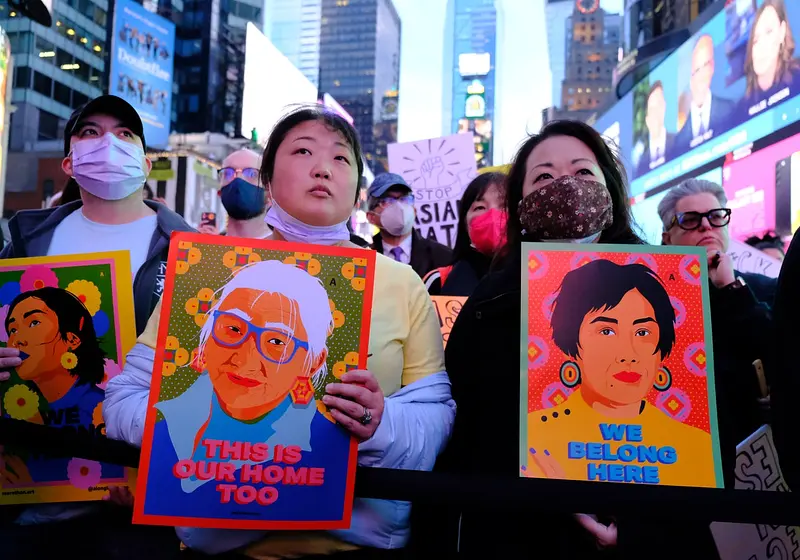The American Dream, equating hard work and success, believing in grit and persistence yielding results, trusting in freedom and choice as inalienable rights, is the framework of America.
For centuries, our nation has wanted to believe in the American Dream's verity, hoping it was obtainable, hoping that America had the potential for upward mobility. This dream, a fantasy that immigrants left their belongings and soared the world for was an idea that made it all worth it: the promise of happiness was something they'd be willing to do anything for.
The American Dream sets a premise that any problem can be overcome with persistence and tenacity. Whether that be racism, segregation, or blatant oppression, America wanted to believe that there was no problem that cannot be overcome by hard work.
From this very belief bloomed the model minority myth.
Let us slide into your dms 🥰
Get notified of top trending articles like this one every week! (we won't spam you)What is the model minority myth?
In 1966, during the Civil Rights Movement, an article written by William Peterson titled, "Success Story, Japanese-American Style" introduced the term "model minority." In this article, Peterson asserted that due to "perseverance" and Japanese people being "extremely law-abiding alien residents," they were able to "overcome" systemic racism and gravitate towards the American Dream. This article, considered "riveting" and "life-changing" upon its release, changed the landscape as which Asians have been perceived.
Since this article, the term "model minority" has been used to primarily describe Asian communities, and notably place them against other racial groups for their "all-rounded success." This myth most commonly characterizes Asian Americans as law-abiding, studious, and overwhelmingly polite, and appraises Asian Americans as a group for being the most "economically, academically, and socially" successful in comparison to other racial groups.
Now, some may wonder, what harm does being characterized as the most successful group do? Isn't it a compliment?
In short, no. This term is often used to pit Asian Americans against other racial groups (particularly black/indigenous communities) without understanding the diversity in Asian American groups. Thus, it masks the struggles faced by a diversely composed community, while serving the purpose of underplaying the effects of segregation and slavery on black communities.
In The Land of the free, every American is still a prisoner of their own stereotypes.
Take the Quiz: Which Indian city is the perfect holiday spot for you!?
Let's match you with an Indian city that you would love!
Why is the model minority myth problematic?
1. It largely generalizes Asian Americans and disregards the versatility within the Asian community.
The model minority myth fails to account for the diverse composition of the Asian community and thus, doesn't account for the disparities within the Asian community.
Metrics broadly state that Asian Americans have the highest median income among different racial groups, without accounting for the fact that Asian Americans also have the largest income gap or income disparity of any racial group.
In 2016, it was discovered that income inequality in the United States is increasing most quickly among Asian Americans. More specifically, Asian Americans in the top 10% of the income distribution earned 10.7 times more than those in the bottom 10%. In comparison with other communities, the disparity between the lowest/highest 10% in black communities is 9.8, and in white and Hispanic communities, the difference is 7.8.
Regardless, when metrics that describe Asian Americans as having the largest median income among all other groups are presented, they disregard the striking income gap between the communities, thus only projecting that the top 10% make more than any other group, which, in turn, is what society internalizes.
Source: Pew Research Center
2. It perpetuates racism, both in and out of the Asian community.
When an entire group of individuals is generalized as submissive, polite, nerdy, and foreign/alien, it inevitably creates implicit biases within society.
For example, NYC mayoral candidate Andrew Yang was subject to a racist caricature that portrayed him with slanted eyes, buck teeth, and as a perpetual foreigner. These images that were widespread during WWII express the internalized feeling that Asian Americans, and immigrants, are foreigners that don't belong in this country.
Though Andrew Yang and his wife are both long-time residents of New York, his Asian nationality was enough to cast him as a foreigner, a dangerous belief that expresses that, even in 2021, while our country has drastically changed, society still believes an American to look how they did in the 1800s.
Even in 2021, an American must fit a predetermined, colonial mold to be deemed American.
Moreover, this myth is often used as the "poster child" example for immigrant groups in America. It is used to characterize other minority groups as "lazy" and underplay the effect of systemic racism, and in turn, establish a hierarchy of which Asian Americans are on top.
The model minority group was particularly enacted to minimize the effect of racism on other groups, particularly Black Americans. This myth falsely conflates the types of racism that both groups have faced. Through various types of legislation, most notably the Chinese Exclusion Act of 1882, and Japanese internment in the 1940s, Asians have faced discrimination, oppression, and racism.
When describing the comparison between Asian and black oppression, Professor Claire Jean Kim at the University of California Irvine asserts that Asian Americans have never faced the "systematic dehumanization that black people have faced during slavery and continue to face today." She continues to say Asians have been barred from the United States and sent to internment camps, which is different from the segregation, police brutality, and discrimination that African Americans have endured.
3. It doesn't take into account the historical background.
The Immigration and Nationality Act of 1965 under President Lyndon B. Johnson was, in simple terms, preferential immigration. It abolished the racist quotas initially in place, with the ulterior motive of wanting to improve relations between the United States and Asia.
The Immigration and Nationality Act particularly aimed to attract those with skilled labor (as promised by lobbyists), so, as a result, it was the doctors, engineers, and entrepreneurs from India that migrated to be able to pursue the American Dream. As Sanjena Sathian cleverly explains, "India itself is not a nation of doctors, engineers, and entrepreneurs, but often, those are the qualifications to stand a chance at the American Dream." In turn, this mass migration of skilled labor has created breeding that is tailored towards upward mobility.
How do we see the model minority myth play out in our daily life?
We see the model minority myth on a scale from microaggressions to macroaggressions. The little comments many of us may have heard in schools, "of course she's good at math, she's Asian" or "no wonder he got in to [university], he's Asian" are microaggressions that hastily generalize the broader Asian community and contribute to incredible pressure and ostracisation for Asian youth.
We've also seen a stark rise in hate crimes against the Asian American Pacific Islander community. Due to Asians being generalized as a group that has "overcome racism" collectively, many of these hate crimes were not even acknowledged to be hate crimes due to the underlying internalization of this myth.
What can I do now that I know this?
First and foremost, seek to understand. Collectivism and different cultural identities are not mutually exclusive. Collectively, terms such as AAPI (Asian American Pacific Islander), exist to develop a political identity rooted in unity. As seen in the Civil Rights Movement, a collective identity serves as a strong weapon against oppression and racism.
It is important to note that even a collectivist group shares vast differences. Within the AAPI community lies a multitude of different cultures and backgrounds that entail different histories, which are important to acknowledge. Reading books written by AAPI can be another easily accessible tool that aids in understanding.
Collectivism and different cultural identities are not mutually exclusive.
Engage in conversations. A calm exchange of words has the potential to serve as an instigating tool to diversify an individual's point of view.
Finally, as you encounter the world, remember that the most powerful tool you are given is the ability to listen. Once you've gained knowledge, your voice can be used to amplify those that are marginalized.









